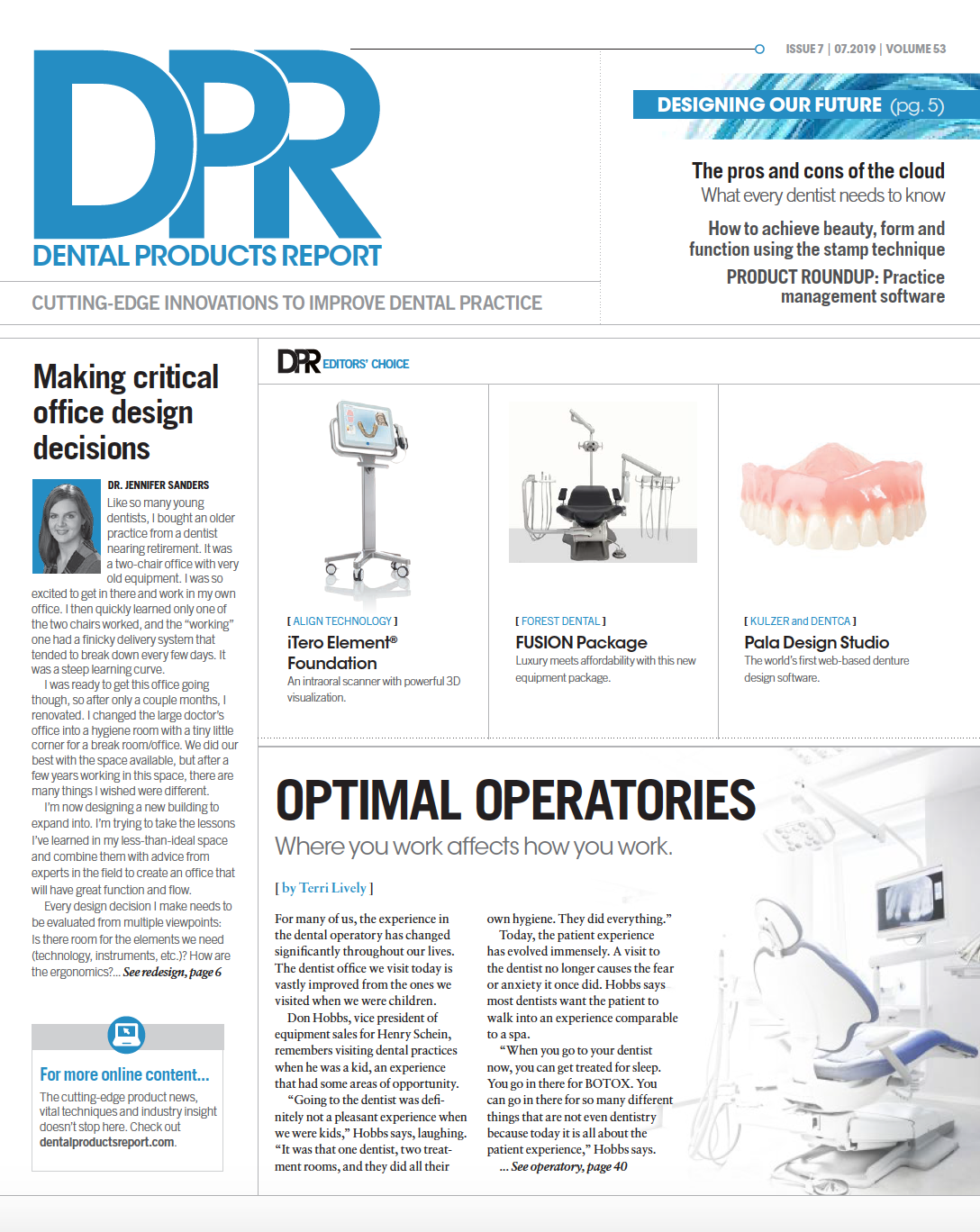Optimizing your practice for success
When planning new operatories or practices, don’t forget to consider your current and future technology needs in those clinical spaces.

Technology changed our society greatly in the last couple of decades, and almost always for the better. We can all point to things we miss about a simpler and perhaps slower pace of life, but any complaints can be easily overridden by the tremendous benefits we all enjoy.
The majority of those benefits come from time savings. When was the last time you actually looked something up in a book? While I actually enjoy the feel and smell of a good book when I’m reading for relaxation, I don’t get the same feelings from a dictionary or a textbook on removable partial denture design.
One of the reasons I’m so passionate about technology is it lends itself to increased efficiency. In the “old days” of paper charts, things went like this:
My staff wrote the majority of the clinical chart notes. Because so many of our procedures vary only slightly in clinical notations, at the end of the day (or between patients), I reviewed the notes and made any necessary changes.
Before being digital, there was rarely time between patients, so writing the chart notes had to wait until the end of the day. The staff would scribble down notes such as blood pressure, anesthetic, etc., and then transfer the info to the permanent chart.
More from the author: Change is good when technology is in the mix
Once done with their portion of the notes, the staff members would come to my personal office and drop a stack of charts on the corner of my desk, where they would land with a heavy “thud” before they happily said goodnight.
I, however, would spend approximately another hour going through all info and making my notations. Usually somewhere around 90 minutes after the last patient left, I would pack up and head home. The first few years in practice I actually worked two nights per week until 7 p.m., meaning I would often get home at around 9:30 p.m. There wasn’t much free time on those evenings.
For years, I’ve been into efficiency. My interest started out as an infatuation with all things tech, but as tech grew into my daily treatment routines, I began to see how my job got easier with each new implementation.
The layout
It never hurts to have luck on your side, and so it was for me. I started my career in a small three operatory office designed and outfitted in the late ’80s. At that point, no one had begun to conceive of workstations in the operatories. I had to basically “shoehorn” the technology into any available space-and trust me, I didn’t have much. We ended up with cords all over the place, things attached to the walls just to keep them off the ground, you name it.

Back then, it helped that technology in healthcare was basically unheard of. Patients were very understanding of what I was trying to do and put up with the “mad scientist” look of my operatories. However, it drove me crazy.
I built my own building in 2007. It was one of the best things I’ve done. By then, I had moved the office to a total and complete digital entity, but I’d been forced to do so in a non-digital structure. We were practicing out of individual treatment rooms and bringing in carts and portable equipment that crowded the space.
When I built the new office, I purchased 1.25 acres, which gave me more than enough room to build to my own specifications. At that time, the standard dental operatory was 9 feet by 11 feet. I expanded this to create operatories of 12 feet by 15 feet. My thought was to design the operatory first, and then build out from there
Trending article: How to design optimal operatories
The increased square footage made bringing in portable equipment such as digital impression systems and hard tissue lasers much easier and eliminated the claustrophobic feeling of too much hardware wedged into too small a space.
The only thing to be aware of is X-ray heads need to be equipped with longer arms to reach the greater distance between the unit and the chair. Otherwise, no special changes were needed.
If you’re building new, whether it’s your own building or a tenant finish, always remember to begin with the end in mind. The operatories are where you and your patients spend the bulk of your time. Design them perfectly first, then move on to the rest of the office. Don’t neglect your primary workspace.
Continued on page two...
Powering everything up
The idea of technology, especially in the clinical realm, is to work with less effort and greater efficiency. The entire concept is to create a delivery system without any bottlenecks. The limiting factor isn’t the technologies; it’s getting them to all light up at once.
The problem with bringing more technologies into the operatory is “Where do I plug them all in?” This is a common problem and one you’ll really need to think through whether you’re doing any type of construction or adding electronics to an existing clinical layout.
My former office was in a strip mall, and I eventually added so much gear I had to have Kansas City Power & Light drop a second electrical service to my location. I was using more power and required more breakers. It wasn’t cheap, but quality rarely is.
As you expand your clinical tech, don’t be afraid to spend some money expanding your underlying infrastructure. When the dental technology wave was just building speed, nobody cared much about a few visible cords, but now patients pay a lot more attention to the details of your office. They’ll notice four outlets with six power strips plugged in (and so will your local fire inspector). The money you spend on proper infrastructure isn’t money wasted. It’s an investment in the internal marketing of your practice.
As far as the number of outlets needed? This is a tough question because everyone’s needs vary. I think a good rule is to figure out the number you currently need, then double it. If you’re a gearhead like me, triple it. If you put in too many outlets, you’ve only overspent a little. If you don’t have enough, you have to add more later, which is more expensive. Make it easy on yourself.
Also, bear in mind that outlets can be hidden. They can be placed inside cabinetry, in dropped ceilings, or in the basement. I was once in an office with a basement and beneath every operatory they had built in a big group of outlets. They would just run the new cord into a cabinet and through a hole in the floor. It was genius.
Speaking of cabinetry, manufacturers have done an incredible job of designing their products to contain and hide technology. They have lots of outlets and mounting brackets for monitors and lots of other things. Take the time to find the right layout for you.
Related reading: Making critical office design decisions
Mistakes? I’ve made a few
The biggest mistake I made was evaluating counter space. I enlarged the operatory to accommodate technology, but I didn’t enlarge the counters to hold the smaller devices. We all bump into the “counter space real estate” problem, and the only way to fix it is to let the manufacturers know we NEED more. I don’t think things in this realm have really changed since the ’80s, and it’s a problem in dire need of fixing.
Track lights are also a thing of the past. When I built the new office, I was already working with a very strong light on my surgical telescopes, so I didn’t bother to have track lights installed in four of the seven operatories. Because I had three ops in my old location, I brought those three lights and installed them in the three new hygiene operatories. One of them has now been totally removed and the other two are never used. It’s easier and less expensive to provide a headlight for clinical staff, plus it makes the operatories look more inviting.
My idea with the operatories was to have them be set up similar to delivery rooms in hospitals. They look like high-end hotel rooms with no clutter and a relaxing atmosphere. However, when equipment is needed, panels open in the walls and it transforms into a medical delivery area. Keeping the operatory with clean lines and inviting ambience will win patients over.
Wrapping up
Streamlining your operatories for efficiency will make things easier on patients, staff and the doctor. That efficiency can be used to make appointments faster, allowing the doctor to add procedures to the day or spend less time doing dentistry. Dentistry takes a physical toll on the doctor. The less time we spend in “the clinical posture,” the better for our physical well-being and career longevity.
Efficiency is great for everyone. No patient has ever asked me to make an appointment longer, and as our lives become busier, we have less time to waste.
The great thing about technology is the win-win-win equation it creates. Better, faster, easier are three things no one will argue about. Efficiency is a wonderful thing!

ACTIVA BioACTIVE Bulk Flow Marks Pulpdent’s First Major Product Release in 4 Years
December 12th 2024Next-generation bulk-fill dental restorative raises the standard of care for bulk-fill procedures by providing natural remineralization support, while also overcoming current bulk-fill limitations.